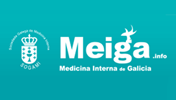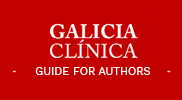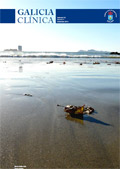Abstract
RESUMEN
OBJETIVOS: Existen diferentes guías de tratamiento de la infección de piel y partes blandas (IPPB), sin embargo el tratamiento de estos pacientes es muy variable. Los objetivos fueron analizar las pautas antibióticas, así como su duración en pacientes con IPPB que precisaron ingreso.
PACIENTES Y MÉTODOS: Se revisaron los pacientes con IPPB ingresados entre enero y diciembre de 2009. Se recogieron las pautas de tratamiento antibiótico empleadas antes, durante y tras el ingreso, así como su duración.
RESULTADOS: De un total de 131 pacientes con IPPB ingresados, se identificaron 41 pautas diferentes de tratamiento antibiótico. En 61 pacientes (47%) se emplearon dos o más fármacos y en 21 (16%) antibióticos de amplio espectro. En 25 pacientes (19%) se modificó la pauta antibiótica por mala evolución y se utilizaron 16 regímenes antibióticos diferentes. En los pacientes con fracaso del tratamiento antibiótico, ni la duración del ingreso (12 ± 9.0 días vs. 14 ± 8.7 días, p = 0.31), ni la duración del tratamiento antibiótico (12 ± 8.2 días vs. 14 ± 6.8 días, p = 0.33) fueron superiores a la de aquellos en los que la respuesta al tratamiento empírico inicial fue adecuada. Al alta, 95 pacientes (73%) recibieron tratamiento antibiótico, se identificaron 25 regímenes diferentes; 22 pacientes (23%) recibieron dos o más antibióticos y antibióticos de amplio espectro se pautaron en 10 casos.
CONCLUSIONES: La IPPB es una causa creciente de hospitalización y, a pesar de existir guías recientes de tratamiento, las pautas de tratamiento antibiótico son altamente variables.
ABSTRACT
OBJECTIVES: There are several clinical guidelines for the management of skin and soft tissue infections (SSTI), however the empirical treatment of patients with this common cause of hospital admission is highly variable. The aims of this study were to determine the empirical antibiotic treatment regimes and the duration of antibiotic treatment of SSTI requiring hospitalization.
PATIENTS AND METHODS: Cases admitted for SSTI were reviewed. We evaluated antibiotic therapy before, during and after hospitalization, as well as duration of treatment.
RESULTS: From the 131 patients, 41 different antibiotic regimes were identified. More than one drug was used in 61 patients (47%), and broad-spectrum antibiotics were used in 21 patients (16%). A change in the antibiotic regimen was required in 25 patients (19%) due to poor clinical response, and 16 different regimes were prescribed. For patients with treatment failure, neither duration of hospitalization (12 ± 9.0 days vs. 14 ± 8.7 days, p = 0.31) nor duration of antibiotic treatment (12 ± 8.2 days vs. 14 ± 6.8 days, p = 0.33) were greater than for those who responded to the initial empirical treatment. On discharge, treatment was prescribed for 95 patients (73%), with 25 different regimes, including a combination of drugs in 22 patients (23%) and broad-spectrum antibiotics in 10.
CONCLUSIONS: SSTI is an increasing cause of hospitalization and, despite recent relevant formal guidelines, management is greatly variable.
© 2014 Galicia Clínica.
Complete article | Pdf article


